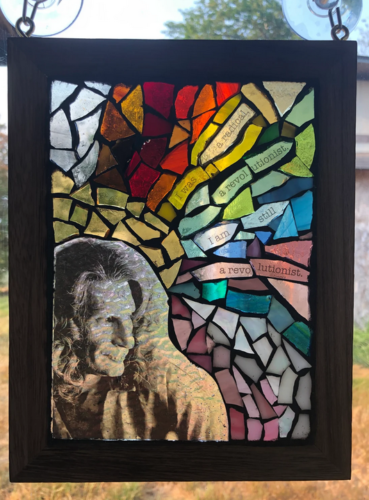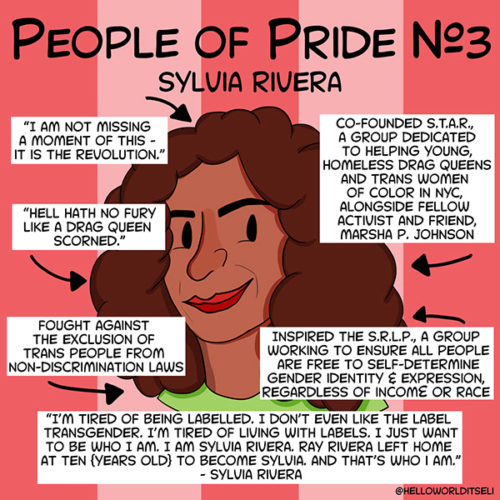Last Updated on June 4, 2025 by Kittredge Cherry
![]()
Sylvia Rivera was a Latina transgender woman activist and one of those credited with starting the Stonewall Rebellion that propelled the LGBTQ liberation movement forward.
She was a founding member of the Gay Liberation Front, which sprang up quickly in 1969 as a result of the Stonewall Rebellion. In 1970 she co-founded the Street Transvestite Action Revolutionaries (STAR), an activist and social service organization for homeless gay and trans street kids.
The LGBTQ people who resisted police at the Stonewall Rebellion (also known as the Stonewall Riots) are not saints in the traditional sense. But they are honored here as “saints of Stonewall” because they dared to battle an unjust system. Some were active in church, but they do not necessarily represent religious faith — they stand for the human spirit and faith in ourselves as LGBTQ people. They performed the miracle of transforming shame into pride.
The historical truth is complex and witnesses disagree about which individual triggered the uprising, when queer people fought back against harassment at New York City’s Stonewall Inn on June 28, 1969. The most commonly named possibilities are all queer people of color: two self-professed “drag queens” Rivera and Marsha P. Johnson, and butch lesbian Stormé DeLarverie. All three have denied throwing the first punch or brick at the rebellion.
David Carter, author of the definitive book “Stonewall,” concludes that none of these three actually started the uprising in his well-researched 2019 article “Exploding the Myths of Stonewall” in the Gay City News.
And yet each of them has been called the Rosa Parks of the LGBTQ community. They have come to symbolize the moment when the LGBTQ community stopped accepting abuse and claimed the right to exist.
Stonewall saints targeted in 2025 website purge
In 2025, more than 50 years after Stonewall, the same government persecution that sparked the rebellion is flaring up again. Sylvia Rivera and other transgender references were deleted from the U.S. National Park Service website in a sweeping campaign to scrub gender identity and LGBTQ resources from federal websites under executive orders by President Donald Trump.
Among the many losses were the bio pages for two trans leaders who symbolize Stonewall: Marsha P. Johnson and Sylvia Rivera. Officials also deleted bio pages of two others from the LGBTQ Saints series: 20th-century activist/priest Pauli Murray and the 18th-century preacher known as Publick Universal Friend. While some traces of these pioneers remain elsewhere on NPS.gov, key pieces of queer spiritual history are being erased. In an attempt to divide and conquer, the government allowed butch lesbian Stonewall saint Stormé DeLarverie to remain on federal websites. Click the following link for an archived versions of the deleted page about Sylvia Rivera.
Sylvia Rivera grew up on the streets
Sylvia Rae Rivera (July 2, 1951 – Feb. 19, 2002) was born in New York City to a Venezuelan mother and Puerto Rican father. She was abandoned by her father and orphaned at age 3 when her mother committed suicide. When she was 10, Rivera was forced onto the streets by a grandmother who disapproved of her gender nonconformity and began working as a prostitute.
On Halloween night 1963, 11-year-old Rivera met and quickly befriended Marsha P. Johnson, who had just moved to New York City after graduating from high school. Johnson taught Rivera how to apply make-up, live on the streets, and embrace her trans identity.
The similarities between Johnson, Rivera and medieval saints is explored in depth in the scholarly article “The Afterward: Sylvia Rivera and Marsha P. Johnson in the Medieval Imaginary” by Joy Ellison and Nicholas Hoffman in the October 2019 issue of Medieval Feminist Forum.

Sylvia Rivera candle by Robin Markle
Rumors say that Rivera threw the first bottle at police, inciting the Stonewall Rebellion.
In 2001 she became an active member of Metropolitan Community Church of New York, where she directed the food service program that feeds the hungry and ministered at the queer youth center. These have now been renamed in her honor as the Sylvia Rivera Food Pantry and Sylvia’s Place. Her ministry at MCC-NY is described in depth in the 2023 book “Kids on the Street: Queer Kinship and Religion in San Francisco’s Tenderloin” by Joseph Plaster. He reports that Sylvia’s ashes are venerated as “saintly relics” in an urn on a pedestal behind the altar of the worship space.
Rivera’s activism extended to poverty and racial justice as well as LGBTQ equality. She is the first transgender American to appear at the National Portrait Gallery in Washington DC. They displayed a photo of her at a Pride March by Luis Carle. She died of liver cancer at age 50.
Rivera smiles with a sidelong gaze and stylized halo in the modern icon at the top of this post by Chicago artist Jen Casselberry. She created it for a commissioned series of seven activist/contemplative icon paintings.
Sylvia and Marsha co-founded an activist group
 Rivera and Johnson were close friends who were both actively Christian. They sometimes appear together in images by various contemporary artists. They are even the subject of a 2020 picture book for children ages 4 to 8: “Sylvia and Marsha Start a Revolution!: The Story of the Trans Women of Color Who Made LGBTQ+ History.”
Rivera and Johnson were close friends who were both actively Christian. They sometimes appear together in images by various contemporary artists. They are even the subject of a 2020 picture book for children ages 4 to 8: “Sylvia and Marsha Start a Revolution!: The Story of the Trans Women of Color Who Made LGBTQ+ History.”
Prints of Marsha P. Johnson and Sylvia Rivera are available from the SleepyDolores Etsy shop
Many members of STAR were religious, as Rivera explained in an interview quoted in “The Gay Liberation Youth Movement in New York: ‘An Army of Lovers Cannot Fail’” by Stephen Cohen.
“We’d all get together to pray to our saints before we’d go out hustling. A majority of the queens were Latin and we believe in an emotional, spiritualistic religion. We have our own saints: Saint Barbara, the patron saint of homosexuality, St. Michael, the Archangel; La Caridad de Cobre*, the Madonna of gold; and Saint Martha, the saint of transformation. St. Martha had once transformed herself into a snake, so to her we’d pray: ‘Please don’t let them see through the mask. Let us pass as women and save us from harm.’ And to the other three we’d kneel before our altar of candles and pray: ‘St. Barbara, St. Michael, La Caridad de Cobre: We know we are doing wrong, but we got to live and we got to survive, so please help us, bring us money tonight, protect us, and keep evil away.’”
*also known as Our Lady of Charity
In 2019 New York City announced plans to commission a statue of Rivera and Johnson, describing it as the “first permanent, public artwork recognizing transgender women in the world.” The monument is scheduled to be finished in 2021 and located in a park one block from the Stonewall Inn. A campaign is underway urging the U.S. Postal Service to issue stamps honoring LGBTQ heroes: three drag icons, Johnson, Rivera and José Julio Sarria, legendary San Francisco drag queen who founded the Imperial Court in 1965; and Urvashi Vaid, lesbian activist and the first woman of color to lead a U.S. national gay-and-lesbian organization as executive director of the National LGBTQ Task Force from 1989-1992.

“Saint Sylvia: Glass on Glass Mosaic” by Colleen Borst used to be available at the Modern Hexology Etsy shop
Rivera is honored in a hanging stained-glass mosaic by Colleen Borst. The glass-on-glass piece features a photographic portrait and her quote “I was a radical, a revolutionist. I am still a revolutionist.”

“Sylvia Rivera: People of Pride No. 3” by Elijah Haswell
Rivera is also included in the “People of Pride” project by Elijah Haswell, a queer transgender artist dedicated to accessible, inclusive non-fiction. The series celebrates historic LGBTQ+ Americans with cartoon-like portraits, boxes packed with fun factoids, and a quick quotation. Haswell began the series in 2018 and it was so popular that a “People of Pride” book was released in 2019 with redrawn illustrations and its own Kickstarter campaign.
Related links
“Street Evangelists and Transgender Saints: Sylvia Rivera, Marsha P. Johnson and the Religions of the Afro-Americas” by Ahmad Greene-Hayes in May 2024 issue of QTR: Journal of Trans and Queer Studies in Religion
Book: “Stonewall: The Definitive Story of the LGBTQ Rights Uprising that Changed America” by Martin Duberman, classic re-released in 2019
Book: “The Stonewall Reader,” edited by New York Public Library, 2019
Book: “Stonewall: The Riots That Sparked the Gay Revolution” by David Carter
Video: “American Experience: Stonewall Uprising”
2015 book for teens: “Stonewall: Breaking Out in the Fight for Gay Rights” by Ann Bausum
___
Top image credit:
“Sylvia Rivera” icon by Jen Casselberry. Prints are available at her Etsy shop
___
This post is part of the LGBTQ Saints series by Kittredge Cherry. Traditional and alternative saints, people in the Bible, LGBT and queer martyrs, authors, theologians, religious leaders, artists, deities and other figures of special interest to lesbian, gay, bisexual and transgender and queer (LGBTQ) people and our allies are covered.
This article was originally published on Q Spirit in June 2020, was expanded with new material over time and was most recently updated on June 4, 2025.
Copyright © Kittredge Cherry. All rights reserved.
Qspirit.net presents the Jesus in Love Blog on LGBTQ spirituality.





















Thank you Sylvia.